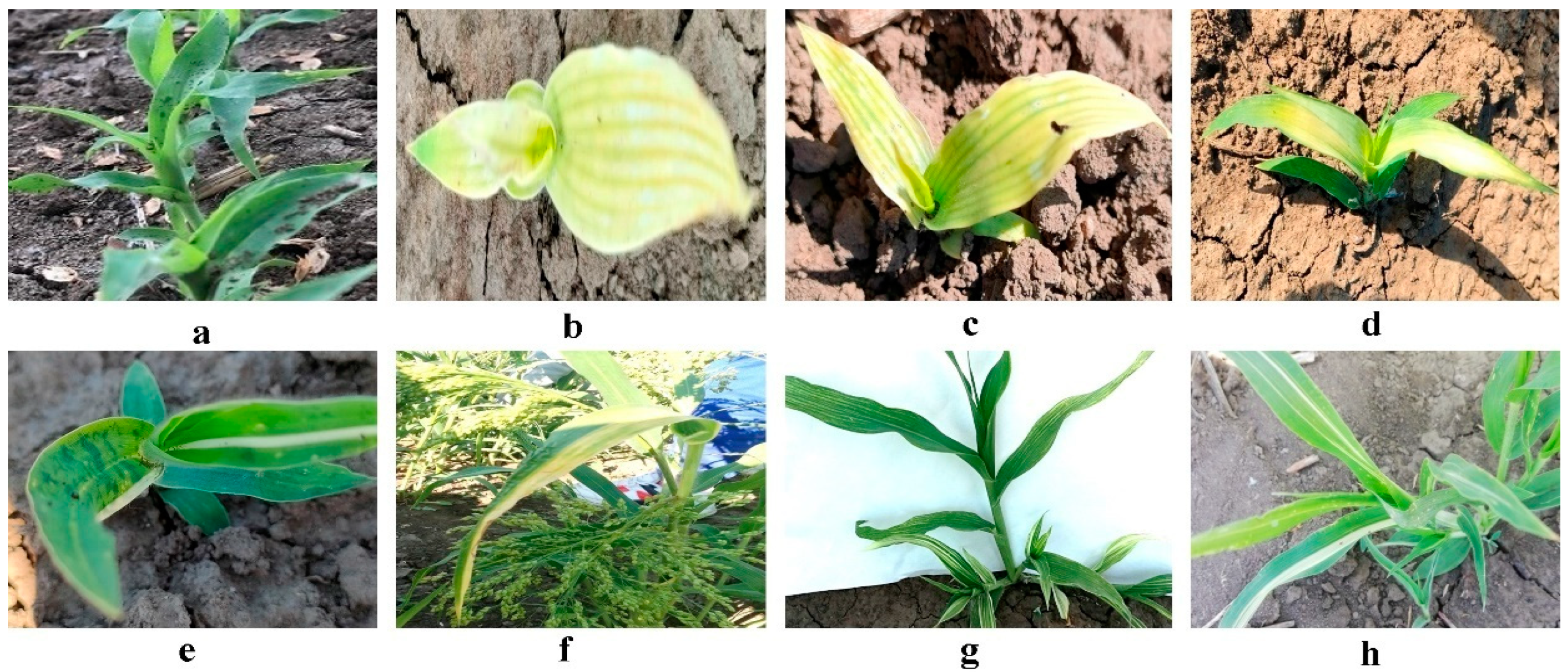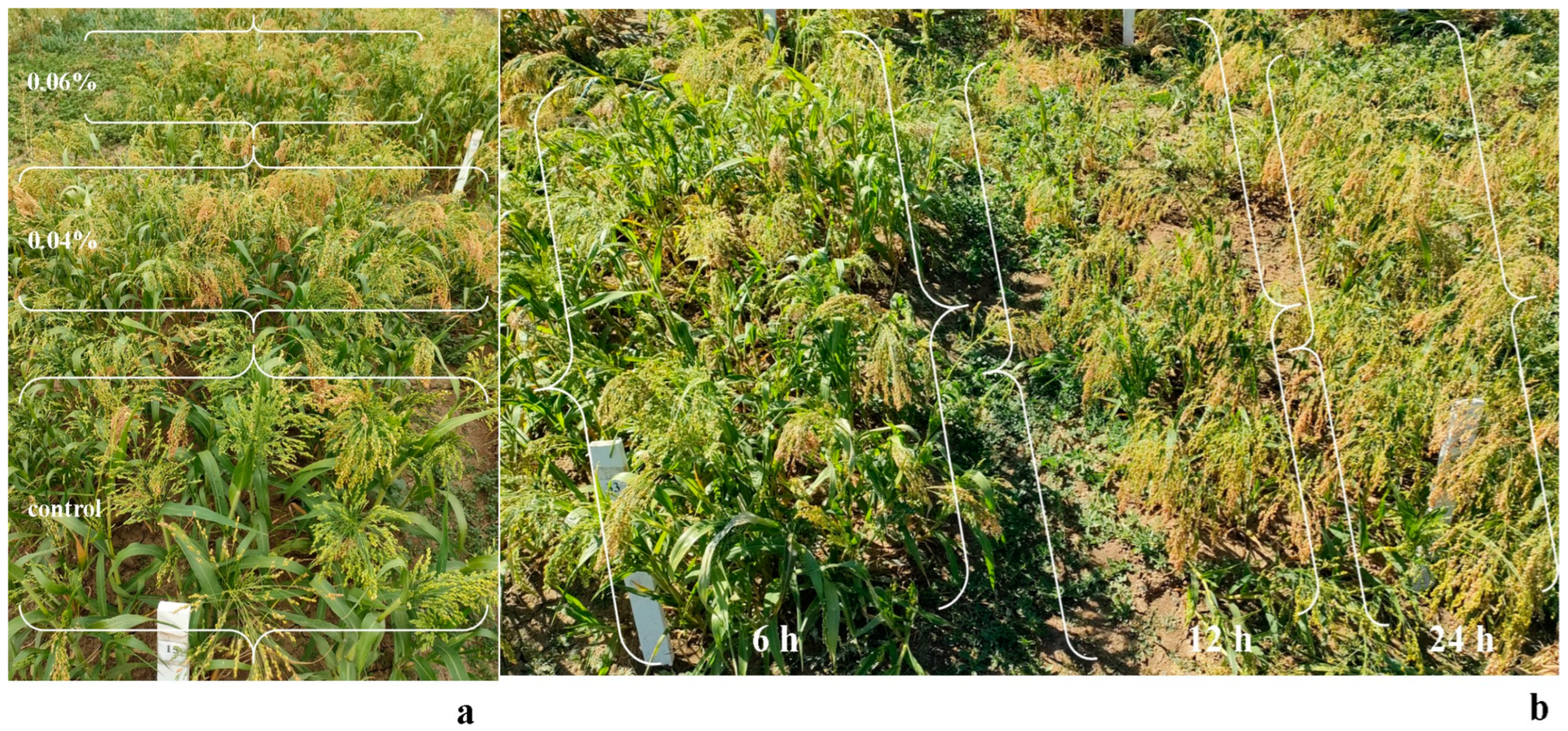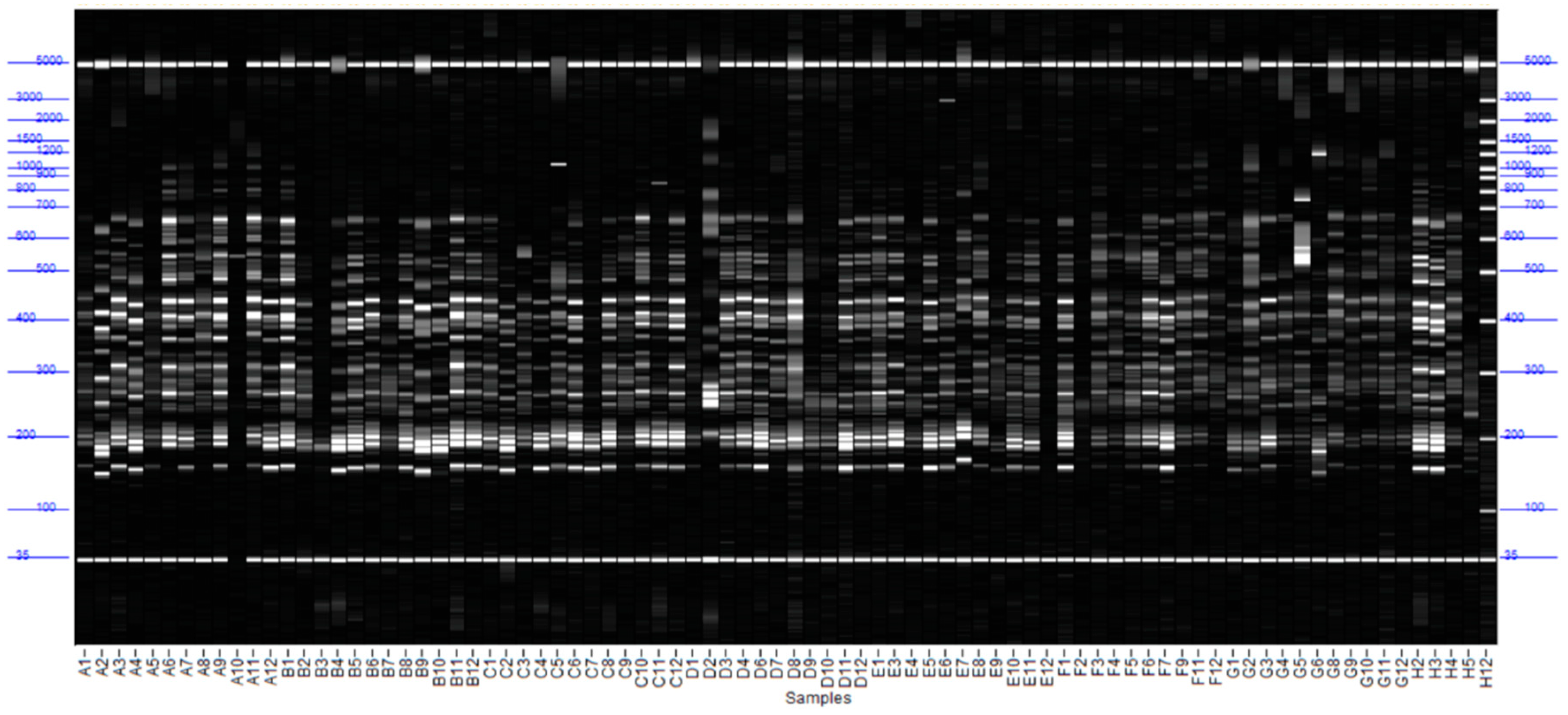3.1. Colchicine effect on field germination
The effects of colchicine on field germination were assessed at the early stage. The germination percent of seeds in M
1 generation decreased with increasing colchicine concentration and treatment period. However, non-significant effect of treatments concentration and duration in second generation were observed. Mean performance germination (%) of M
1- and M
2-generations (2021-2022) of proso millet genotypes affected by different concentrations and treatment time of colchicine are given in
Table 2.
Our results indicated that the germination decreased under colchicine effect. The lowest germination percentages were detected at 0.1% with 12 and 24 h exposure duration in M1- and M2 generations. The highest germination percentages were recorded at 0.04% with four h exposure duration for M1- and M2-generations. The mean germination in M2 generations was higher than in M1 under colchicine effect. In M1 generations the mean germination was 69.6% at control sample, at 0.04% of colchicine - 53.4%, at 0.06 of colchicine - 49.7%, at 0.08% of colchicine -44.4% and at 0.1% of colchicine was 29.8%, while in M2 it was 75.3, 63.5, 55.2, 49.1 and 32.7%, respectively. It was found that long-term colchicine treatment of seeds leads to a decrease in germination compared to a short-term treatment.
3.2. Identification and characterization of chlorophyll-deficient foliar mutants
The morphological analysis was conducted in 2021 for M1 plants, in 2022 for M2 plants. Seven different types of chlorophyll mutants (albina, сhlorina, viridis, lutescent, corroded, maculata and striata) were found in M1 and M2 generations when field seedlings were 10-20 days old.
Chlorophyll-deficient foliars were determined according to the main clearly expressed mutant trait in comparison with the control sample (original genotype without treatment). The results showed that the high concentration (0.08-0.1%) of colchicine induced the following types of mutations in M
1 plants at germination-tillering stage: albina (white seedlings), weaker and relatively smaller seedlings compared to normal ones. With sufficient humidity and low temperature, 1-2 pairs of true white leaves managed to form. The plants wilted at the early stages of development (within two weeks) (
Figure 1b); chlorina plants had yellow seedlings, the true leaves were also yellow or yellow-green, and the plant did not change color as it grew. The plants lagged far behind both in growth and development, and often wilted (
Figure 1c); viridis (viridis) - light green shoots. True leaves and the whole plant were pale green and thin. There was a lag in growth (
Figure 1d); (lutescent) - the first leaves were green. As they grew, the upper part of the plant was clearly distinguished by a light green with a yellow tint, while the rest of the plant remained green. The “golden tip” type was the most suitable description for the change (
Figure 1e); corroded - the primary leaves were green. The real leaves were yellow-green in color and deformed, the edge of the leaf dried up and curled up, and there were necrotic spots on the leaves (
Figure 1e); maculate seedlings showed whitish dots on the leaves or necrotic spots. The plants were vigorous, matured with a delay, and produced few seeds (
Figure 1g); striata - the first leaves were green. The plant was green, the leaves had a longitudinal stripe: white or yellow (
Figure 1h).
In M
1 generations, a total of 2214 families were studied. At all the concentrations of the mutagen, except for 0.04%, chlorophyll mutations were detected. A total of 248 families with modifications were selected in M
1, while in M
2 generation 500 plants from each family were analyzed (
Table 3).
Chlorophyll-deficient foliar were detected in M1-M2 seedlings and adult plants mostly at high concentrations of colchicine (0.08 and 0.1%). These chlorophyll-deficient foliar were found with a fairly high frequency, especially within the PI289324 genotype. In M1 plants, at colchicine concentrations of 0.06-0.1% the overall frequency of chlorophyll changes was 17.4% generally for the viridis type. There were no changes at 0.04% colchicine concentration in M1 and M2 generations. Chlorophyll mutations with a lethal outcome were revealed: white seedlings of the albina type and yellow seedlings of the chlorina type. The death of these mutants occurred at the stage of the first leaves. Some mutants survived, but they severely weakened and lagged behind in growth and development comparing to the control plants. Albina type was observed with the frequency of 8.6% at 0.08% and 0.1% colchicine concentrations in M1 plants, 0.4% at 0.1% colchicine concentration in M2. In M1 plants the lutescent "golden top" type was observed with a sufficiently high frequency only at 0.06-0.1% colchicine concentrations with a frequency of 1.4, 3.4 and 6.8, respectively. Corroded type was observed in all genotypes with a relatively high frequency, and the maximum appearance was achieved at 0.08% colchicine concentration, while in M2 this type of mutation was not detected. In maculata mutation type seedlings showed whitish dots on leaves and necrotic spots, M1-M2 plants were vigorous, matured with a delay and produced few seeds; this mutation type was attained only at higher 0.1% concentration of colchicine. Striata mutation was presented by white or yellow stripes on the leaves and observed at higher colchicine concentrations (0.08 and 0.1%) with the frequency of 3.7 and 5.9% in M1, 0.4 and 0.6% in M2 respectively.
3.3. Agronomic trait components
In total, seven agronomic traits associated with the vegetative period and yield elements were evaluated: plants survival (PS), growing season (GS), productive branches (PB), seed weight per panicle (SWP), 1000 seeds weight (TSW) and grain yield (GY). The data analysis indicated that there was a wide range of variation responses of genotypes to various colchicine treatments (
Table 4).
Colchicine treatments resulted in a lower PS rate than control. The lowest PS rate was observed in case of 24 hours’ treatment at 0.08-0.1% colchicine concentration for M1- and M2 plants. Longer soaking times at the highest colchicine concentration (0.08-0.1%) had negative effects on this trait for both the M1- and M2- generations. For example, the PS rate in Quartet variety was 61 and 66% in M1-and M2 control plants, while at 0.1% with 24 h treatment time it was 24 and 16%, respectively. The greatest colchicine concentration (0.1%), combined with the longest soaking time (24 h), generated the smallest PS rate for M1 and M2 plants.
The GS in both generations varied with different mutagenic concentrations. The results obtained from the M
1 and M
2 generations demonstrated significant mutagen effects on GS for all genotypes. With increasing mutagen concentration, the GS decreased for 4-5 days (
Figure 2a). In both the M
1 and M
2 generations, the GS was the lowest at 0.08-0.1% with 12 and 24 h soaking time (
Figure 2b). Average mean of the GS of PI289324 genotype was lower than the ones of Pavlodarskoe 4 and Quartet cultivars. The trait values ranged from 78 to 92 days in the M
1 and M
2 generations.
The figure 2 indicates that the growing season of proso millet for the control plants was delayed comparing with the colchicine-treated plants. In the M1 and M2 generations, variation was observed in some agronomics traits, such as 1000 seeds weight, seed weight per panicle and productive branches. The increase in colchicine concentration led to rise in number of the PB per plant in M1 and M2 generations. The 0.08-0.1% colchicine concentration combined with exposure durations of 6, 12 and 24 h significantly increased the observed number of PB per plant, approximately by 25% to compare with the control. The highest concentration of colchicine combined at 6, 12, and 24 h exposures durations resulted in the highest number of PB.
Significant differences were detected in SWP for both the M1 and M2 generations. The maximum values of SWP were 3.3 g for M2 Quartet plants at 0.1% colchicine concentration treatment, 3.2 g for Pavlodarskoe 4 cultivar at 0.1% colchicine and 24 h exposure, 2.5 g for PI289324 variety at 0.04% colchicine, 12 h exposure. The least values of SWP were at 0.06% concentration for Quartet genotype (1.3 g) and at 0.1% concentration, 24 h exposure for PI289324 variety, and at 0.08% concentration, 6 h exposure for Pavlodarskoe 4 cultivar (1.1 g). In general, the treated M2 plants prevailed over the control for M2 Pavlodarskoye 4 genotype after 24-hour treatment and for Quartet variety at all concentrations and exposure durations, except for the 0.06% concentration, 24 h treatment. Concerning M2 PI289324, the SWP for the control variant was higher than for the treated sample.
We have evaluated the GY performance of M
1 and M
2 plants under various colchicine concentrations combined with soaking time. The data presented in
Table 4 suggests that the GY in the M
1 generations reduced with increasing colchicine dose (0.08-0.1%), whereas the opposite was observed at concentration 0.04-0.06% combined with 12 h soaking time. As for GY, the highest value was obtained in M
2 of Quartet (67.6) at 0.04% concentration, in Pavlodarskoe 4 (65.8) on 0.06% concentration and in PI289324 (62.0) on 0.04% concentration at 12 h treatment time. The lowest GY value was in M
2 of Quartet (15.6) on 0.1% and in Pavlodarskoe 4 (17.6) at 0.04%, 24 h treatment time, while in PI289324 (3.2) at 0.1% concentration, 12 h exposure.
There were significant differences in the TSW of M1 and M2 generations. The TSW was higher in M2 generations than M1, regardless of colchicine concentrations and exposure duration. Mean performance for the TSW (5.1-5.8 g) was slightly lower in M1 plants of PI289324 genotype than in control plants (6.0-6.7 g). The highest 1000 grain weight was observed in M1 plants of Quartet variety (7.2 g) at 0.06% colchicine treatment, 24 h exposure.
Factorial analysis of variance was performed to confirm the effect of the treatment durations and mutagen concentration for the studied agronomic traits of M
1 and M
2 plants. The results of ANOVA for FG, PS, GS, PB, SWP, TSW and GY traits are depicted in
Table 5 and
Table 6 for M
1 and M
2 generation respectively.
The results for FG and PS at 12 h and 24 h treatment duration in M
1 plants were observed statistically significant (p<0.05). FG and PS also have significantly affected (p<0.001) by the all colchicine concentrations (0.04, 0.06, 0.08 and 0.1%) in M
1 generation (
Table 5). There were no significant correlations for GS and TSW and colchicine concentration and treatment duration in M
1 plants. The SWP was also related to 12 and 24 h treatment time with 0.031 and 0.004, respectively (P< 0.05 and P < 0.001). There was a relationship between FG and PS and treatment durations of 12 and 24 h in M
2 plants,
P-value was <0.05 and <0.01-0.001, respectively. In addition, it was found that GY was also influenced by 12 and 24 h treatment duration, with
P-value<0.001 and <0.01, respectively. The analysis of variance suggested that FG and PS were highly related with colchicine concentrations 0.06 (P< 0.01), 0.08 and 0.1% (P< 0.001). Concentrations 0.08 and 0.1% showed a significant relationship to GS (P< 0.05). The concentrations of 0.06, 0.08 and 0.1% were related to PB, P<0.05, P<0.001 and <0.01, respectively.
3.4. Molecular analysis
In the present study, 16 ISSR markers were tested. The total number of bands produced by ISSR markers varied from 4 to 53 with an average of 20.82 amplicons per primer. The size of the amplified fragments ranged from 39 bp and 4827 bp, as shown in
Table 7.
16 ISSR primers produced in total 1333 fragments, among them 1281 were polymorphic, with a mean polymorphic percentage of 96.11%. The maximum level of polymorphism was produced by markers ISSR 811, ISSR 820 and ISSR 826 (100%); followed by ISSR 840, ISSR 816 and ISSR 807 98 (98%); the markers ISSR 808, ISSR 817, ISSR 841 and ISSR 823 (97%); the markers ISSR 809, ISSR 822 and ISSR 835 (95). The markers ISSR 810, ISSR 834 and ISSR 819 showed a lower level of polymorphism of 91, 90 and 85%, respectively. The primers ISSR 807, ISSR 810, ISSR 811, ISSR 816, ISSR 835 and ISSR 840 amplified more bands at 0.08% colchicine treatment. The polymorphism information content (PIC) of markers varied from 0.202 to 0.322 with an average of 0.241. The maximum PIC was recorded for ISSR 840 (0.322) followed by ISSR 835 (0.311), while the lowest (0.202) was for ISSR 819. The ISSR 840 marker amplification profile of capillary system is illustrated in
Figure 3, as an example.
Different genetic diversity estimated for three concentrations of colchicine was calculated where the maximum Na was recorded for control (0.913±0.023), followed by 0.08% colchicine concentration (0.801±0.023), 0.04% (0.676±0.022) and 0.06% (0.499±0.020) with an average of 0.722±0.022 (
Table 8).
The Ne was higher at 0.04% (1.232) and lower at 0.06% (1.169), with an average of 1.205. The I ranged from 0.145 to 0.228, with an average of 0.192. The He ranged from 0.099 to 0.147, with a mean value of 0.127. The average value of the uHe was 0.380, with values of 0.181 at 0.04%, 0.176 in control, 0.153 at 0.08% and 0.132 at 0.06%. The average percentage of polymorphic loci was lower at 0.06% concentration (23.92%) and higher at control (45.34%), with the mean 35.49%.








